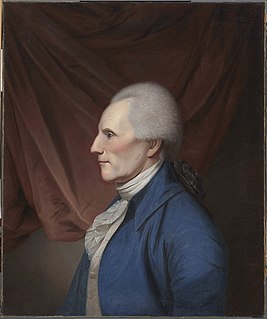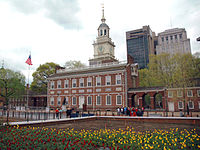
The Articles of Confederation and Perpetual Union was an agreement among the 13 original states of the United States of America that served as its first frame of government. It was approved after much debate by the Second Continental Congress on November 15, 1777, and sent to the states for ratification. The Articles of Confederation came into force on March 1, 1781, after ratification by all the states. A guiding principle of the Articles was to establish and preserve the independence and sovereignty of the states. The weak central government established by the Articles received only those powers which the former colonies had recognized as belonging to king and parliament.

Richard Henry Lee was an American statesman and Founding Father from Virginia, best known for the June 1776 Lee Resolution, the motion in the Second Continental Congress calling for the colonies' independence from Great Britain leading to the United States Declaration of Independence, which he signed. He also served a one-year term as the president of the Continental Congress, was a signatory to the Articles of Confederation, and was a United States Senator from Virginia from 1789 to 1792, serving during part of that time as the second president pro tempore of the upper house.

The Continental Congress was a series of legislative bodies, with some executive function, for thirteen of Britain's colonies in North America, and the newly declared United States just before, during, and after the American Revolution. The term "Continental Congress" most specifically refers to the First and Second Congresses of 1774–1781 and may also refer to the Congress of the Confederation of 1781–1789, which operated as the first national government of the United States until being replaced under the Constitution of the United States. Thus, the term covers the three congressional bodies of the Thirteen Colonies and the new United States that met between 1774 and 1789.

Between 1776 and 1789 thirteen British colonies emerged as a newly independent nation, the United States of America. Fighting in the American Revolutionary War started between colonial militias and the British Army in 1775. The Second Continental Congress issued the Declaration of Independence on July 4, 1776. Under the leadership of General George Washington, the Continental Army and Navy defeated the British military securing the independence of the thirteen colonies. In 1789, the 13 states replaced the Articles of Confederation of 1777 with the Constitution of the United States of America. With its amendments, it remains the fundamental governing law of the United States.

The president of the United States in Congress Assembled, known unofficially as the president of the Continental Congress and later as the president of the Congress of the Confederation, was the presiding officer of the Continental Congress, the convention of delegates that emerged as the first (transitional) national government of the United States during the American Revolution. The president was a member of Congress elected by the other delegates to serve as a neutral discussion moderator during meetings of Congress. Designed to be a largely ceremonial position without much influence, the office was unrelated to the later office of President of the United States. Upon the ratification of the Articles of Confederation in March 1781, the Continental Congress became the Congress of the Confederation. The membership of the Second Continental Congress carried over without interruption to the First Congress of the Confederation, as did the office of president.

The Second Continental Congress was a meeting of delegates from the Thirteen Colonies in America that united in the American Revolutionary War. It convened on May 10, 1775, with representatives from 12 of the colonies in Philadelphia, Pennsylvania, shortly after the Battles of Lexington and Concord, succeeding the First Continental Congress which met in Philadelphia from September 5 to October 26, 1774. The Second Congress functioned as a de facto national government at the outset of the Revolutionary War by raising armies, directing strategy, appointing diplomats, and writing petitions such as the Declaration of the Causes and Necessity of Taking Up Arms and the Olive Branch Petition. All thirteen colonies were represented by the time the Congress adopted the Lee Resolution which declared independence from Britain on July 2, 1776, and the congress agreed to the Declaration of Independence two days later.

Events from the year 1783 in Canada.

The Founding Fathers of the United States, or simply the Founding Fathers or Founders, were a group of American revolutionary leaders who united the Thirteen Colonies, led the war for independence from Great Britain, and built a frame of government for the new United States of America upon classical liberalism and republican principles during the later decades of the 18th century.

The First Continental Congress was a meeting of delegates from 12 of the 13 British colonies that became the United States. It met from September 5 to October 26, 1774, at Carpenters' Hall in Philadelphia, Pennsylvania, after the British Navy instituted a blockade of Boston Harbor and Parliament passed the punitive Intolerable Acts in response to the December 1773 Boston Tea Party. During the opening weeks of the Congress, the delegates conducted a spirited discussion about how the colonies could collectively respond to the British government's coercive actions, and they worked to make a common cause.

The Lee Resolution was the formal assertion passed by the Second Continental Congress on July 2, 1776 which resolved that the Thirteen Colonies in America were "free and independent States", separated from the British Empire and creating what became the United States of America. News of this act was published that evening in The Pennsylvania Evening Post and the next day in the Pennsylvania Gazette. The Declaration of Independence is the formal document which officially announced and explained the resolution, approved two days later on July 4, 1776.

The United States House of Representatives, commonly known as the lower chamber of the United States Congress, along with the United States Senate, commonly known as the upper chamber, are the two parts of the legislative branch of the federal government of the United States. Like its counterpart, the House was established by the United States Constitution and convened for its first meeting on March 4, 1789, at Federal Hall in New York City. The history of this institution begins several years prior to that date, at the dawn of the American Revolutionary War.

The Congress of the Confederation, or the Confederation Congress, formally referred to as the United States in Congress Assembled, was the governing body of the United States of America from March 1, 1781, to March 4, 1789. A unicameral body with legislative and executive function, it was composed of delegates appointed by the legislatures of the several states. Each state delegation had one vote. It was preceded by the Second Continental Congress (1775–1781) and was created by the Articles of Confederation and Perpetual Union in 1781.

Pennsylvania was the site of key events and places related to the American Revolution. The state, and especially the city of Philadelphia, played a critical role in the American Revolution.

The Perpetual Union is a feature of the Articles of Confederation and Perpetual Union, which established the United States of America as a political entity. Under modern American constitutional law, this concept means that U.S. states are not permitted to overthrow the U.S. Constitution and withdraw from the Union.
The Confederation period was the era of United States history in the 1780s after the American Revolution and prior to the ratification of the United States Constitution. In 1781, the United States ratified the Articles of Confederation and prevailed in the Battle of Yorktown, the last major land battle between British and American Continental forces in the American Revolutionary War. American independence was confirmed with the 1783 signing of the Treaty of Paris. The fledgling United States faced several challenges, many of which stemmed from the lack of a strong national government and unified political culture. The period ended in 1789 following the ratification of the United States Constitution, which established a new, more powerful, national government.
The American Revolutionary War inflicted great financial costs on all of the combatants, including the United States, France, Spain and the Kingdom of Great Britain. France and Great Britain spent 1.3 billion livres and 250 million pounds, respectively. The United States spent $400 million in wages for its troops. Spain increased its military spending from 454 million reales in 1778 to over 700 million reales in 1781.
The former Court of Appeals in Cases of Capture, established by resolution of the Continental Congress on January 15, 1780, was the first federal court in the United States of America. The court had jurisdiction over cases for the capture of enemy ships and cargo.

Passport Act of 1782 was enacted by the Congress of the Confederation on February 11, 1782. The Act was recorded in the twenty-second volume of the Journals of the Continental Congress. The passport article was a letter from Thomas Smith of Virginia to George Clymer, Samuel Osgood, and James Madison regarding the nautical trade between tobacco colonies. The Act of Congress states safe passage for the Commonwealth of Virginia traders capitulants seeking to transport tobacco from Yorktown, Virginia to New York.
The Augusta Declaration, or the Memorial of Augusta County Committee, May 10, 1776, was a statement presented to the Fifth Virginia Convention in Williamsburg, Virginia on May 10, 1776. The Declaration announced the necessity of the Thirteen Colonies to form a permanent and independent union of states and national government separate from Great Britain, with whom the Colonies were at war.















